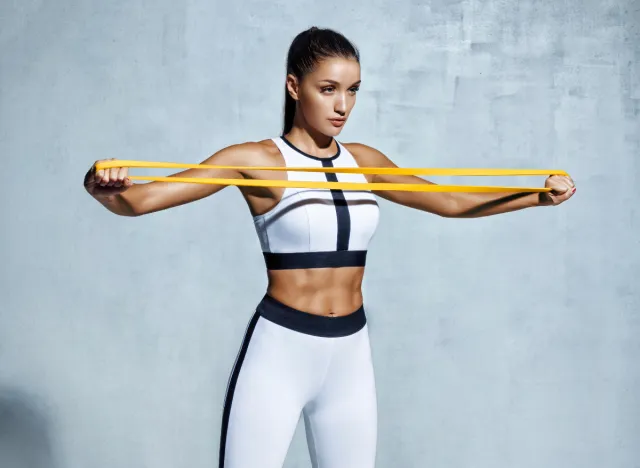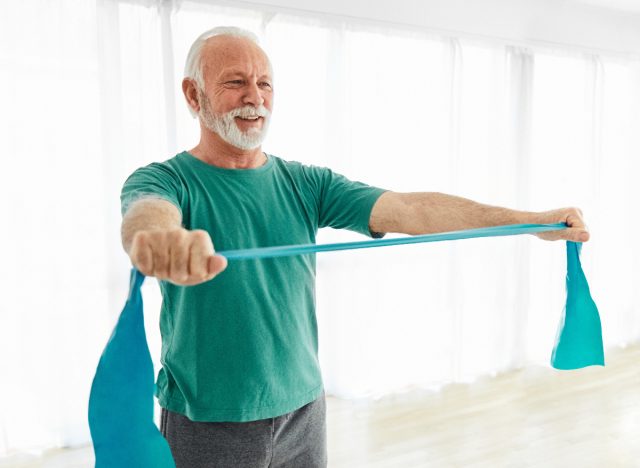What’s Better for Sculpting Your Arms: Resistance Bands or Dumbbells?

It’s always fun to switch up your workout routine. After all, it keeps you from getting bored—and some tweaks can offer even better results. If you’re looking to tone and sculpt your arms, we asked an expert whether resistance bands or dumbbells reign supreme.
What’s Better for Building Strong, Sculpted Arms: Resistance Bands or Dumbbells?

The main difference between training with resistance bands versus dumbbells lies in how each applies resistance to your muscles.
“Dumbbells provide a consistent load throughout most of the movement (depending on body position and gravity), making them great for overloading the muscle at its strongest point,” Luke Jones, a certified personal trainer at HERO Movement, explains. “Resistance bands, on the other hand, offer variable resistance—the further you stretch them, the more tension they produce—which means peak challenge often comes toward the end range. This can lead to more engagement of stabilizing muscles and requires more control throughout the rep. That said, the specific effect can vary depending on the exercise and setup, so both tools can be used creatively to target different parts of the movement.”
This prompted us to ask if bands are better at attaining certain goals. For example, are resistance bands a more effective choice if your goal is to improve muscular endurance or joint health?
Luke explains, “Rather than thinking of it as bands vs dumbbells, it’s more helpful to think in terms of how they complement each other. Bands tend to be more joint-friendly and are great for high-rep work that builds muscular endurance, mind-muscle connection, and control. Dumbbells offer the ability to progressively load movements with heavier weight, which is essential for building strength and muscle mass over time. Both can support muscle growth—it’s more about how you use them.”
Resistance bands offer a flexible resistance curve, potentially placing less stress on the joints. They’re especially great for rehabilitation training or addressing sensitive joints.
“Because the resistance increases gradually, they often feel smoother on the elbows and shoulders,” Luke shares. “Bands also encourage activation of stabilizer muscles and can be anchored in different directions, allowing for more freedom of movement and varied angles that are harder to replicate with free weights.”
Luke points out that it’s not “better or worse,” but rather a different kind of stimulus.
How to Effectively Train With Resistance Bands

Bands can be beneficial in sculpting your arms, although their maximal load is limiting, which is a main driver of muscle growth. If you choose to work with resistance bands, Luke recommends taking the following steps:
- Perform higher volume.
- Keep reps slow and controlled.
- Focus on time under tension.
Using a Combo of Bands and Dumbbells Is Ideal

Both dumbbells and bands are stellar choices to incorporate into your training. Dumbbells offer progressive overload, which is king when it comes to building muscle and strength; while resistance bands are joint-friendly, super easy to travel with, and a great choice for finishers and warm-ups. This makes combining both pieces of equipment beneficial. Using both will work your muscles differently, help you stay interested, and in turn be good for sustainable progress for flexible joints, functional strength, and sculpted arms.
“A great approach is to blend both,” Luke tells us. “You could start with some light banded exercises to activate the muscles and dial in form, then move on to dumbbell work for your main sets. Bands can also be used at the end of a session for high-rep finishers, adding volume without extra joint wear. Beginners might begin with bands to build confidence and control; more experienced lifters can use both tools to vary stimulus and support longevity. It’s less about choosing sides and more about using the right tool for the job.”